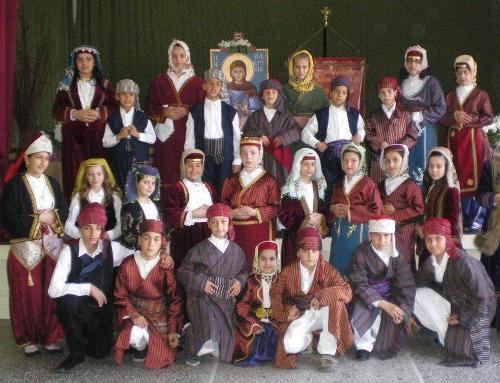GREECE
Population

Population

Cities in GREECE
| Athens |
Popular destinations GREECE
| Aegina | Alonissos | Andros |
| Chios | Corfu | Crete |
| Hydra | Kalymnos | Karpathos |
| Kefalonia | Kos | Lefkas |
| Lesbos | Mykonos | Naxos |
| Paros | Patmos | Peloponnese |
| Poros | Rhodes | Samos |
| Santorini | Skiathos | Skopelos |
| Spetses | Thasos | Zakynthos |
Population
 Cappadocian Greek children wearing traditional costumes in Thessaloniki, GreecePhoto: Zorlusert CC 3.0 Unported no changes made
Cappadocian Greek children wearing traditional costumes in Thessaloniki, GreecePhoto: Zorlusert CC 3.0 Unported no changes made
Greece had 10,451,000 inhabitants in 2024. Approx. 1.5 million Greeks live on the islands where the islands in the Ionian Sea are more densely populated than those in the Aegean Sea. The population density is approximately 78 people per km2.
Approximately 92% of all inhabitants of Greece are actually of Greek nationality. Important minorities are Slavo-Macedonians, Turks in mainly Thrace, and (illegal) Albanians. Small minorities such as Aromoons or Vlachs in Epirus, Armenians, Pomaks and Roma or gypsies can no longer be recognized as such because they are almost completely absorbed into society. About 130,000 Muslims live in Thrace, the majority of whom consider themselves Turkish and they make up about 30% of the total population. They are very unevenly distributed over the area; For example, the district of Evros is closest to Turkey and the population consists of only 7% Turks. In the district of Xanthi this percentage is 30% and in Rodopi it is 55%. The rest of the population are Greek Pomaks, who also live across the border from Bulgaria.
The Aromons or Vlachs live in the central part of Pindos. Their dialect is closely related to Romanian. Before the Second World War, there were about 80,000 Jews in Greece; At present, the Sephardic community in Thessaloniki has about 1,000 members and about 3,000 Romaniot Jews still live in Athens.
The Cyclades Islands of Syros and Tinos are home to descendants of Venetian settlers who still form a Catholic community of about 10,000 people. In Thrace, some of the Roma still live isolated from the Greek population. Many other Gypsies have been completely assimilated into the population and it is estimated that a total of 150,000 Gypsies still live in Greece. The so-called Slavo Macedonians live in the northwest of the province of Macedonia and their number is around 40,000.
The migration to the big cities of Thessaloniki and especially the capital Athens is still great and that is why approx. 78% of the total population lives in the cities. Greece is also a real emigration country. Over the years, about 3.5 million Greeks have moved abroad. Most Greeks emigrated to Western Europe, the United States, South Africa and Australia. This emigration wave mainly took place in the 1960s and early 1970s. Emigration decreased sharply in the late 1970s.
The number of illegal immigrants residing in Greece has grown dramatically in recent years.
Main cities and population:
Greater Athens 3.5 million
Thessaloniki 815,900
Patras e.o. 300,100
Lárissa and others 270,600
Iráklion e.o. 264,900
- The annual population growth in the period between 1990 and 1995 was 0.4% (2001: 0.21%). The number of older Greeks is increasing; in 1971 more than 25% was younger than 15 years, in 1990 21%, in 2001 only 15%; the share of the over-65s rose in the same period from 11% to 17.%.
- The current situation (2024) is:
0-14 years 13.8%
15-64 years 62.6%
65+ 23.6% - The birth rate in 2024 was 7.4 births per 1000 inhabitants; the death rate in the same year was 12 deaths per 1,000 inhabitants. In Greece men live on average 78.4 years, women on average 84.6 years.
Sources
DuBois, J. / Greece
Times Books International
Europese Unie : vijftien landendocumentaties
Europees Platform voor het Nederlandse Onderwijs
Gerrard, M. / Griekenland
Kosmos-Z&K
Koster, D. / Griekenland
ANWB
CIA - World Factbook
BBC - Country Profiles
Copyright: Team The World of Info